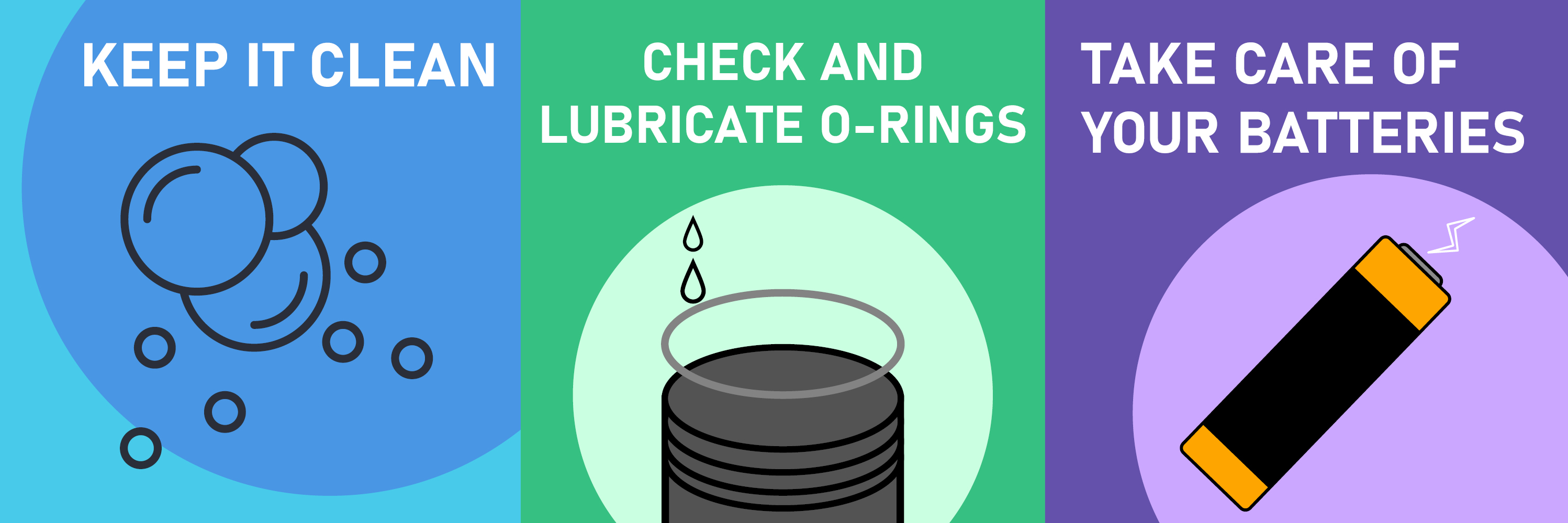Maintenance
Fenix torches are built for extreme environments – after all its in our tag line ‘Lighting for Extremes’. Even the best lights will need a little maintenance from time to time, to keep them running in perfect order. The last thing you want before heading out on your next adventure is to discover an issue with your light!
So here are our 3 easy maintenance tips to follow.

1) Keep it clean
Depending on the environment in which you use your Fenix light, it may require a quick wipe over, or a more thorough cleaning. For an activity such as running, hiking and camping, a quick clean may be all that is needed, whereas, upon returning from a muddy caving adventure a good clean off and scrub is likely to be in order.
Certain conditions such as contact with salt water (sea fishing) can lead to cosmetic damage. Therefore, in these circumstances it’s best to clean the light thoroughly after each use.
Never leave a coating of mud on the light body as this will reduce its ability to shed head, impacting performance and lifespan. Also, immediately clean off any mud from lenses as this prevents the heat energy within the light beam from escaping. This can cause lens damage and overheating, particularly at high brightness settings.
How you can carry out the cleaning task will depend on your lights IP rating.
IP68 – Waterproof
If your light is waterproof to this level, it can be submerged under water, making cleaning simpler. If your light is dirty, all you need is a toothbrush and a bowl of water containing a small amount of washing up liquid. Before submerging the light ensure battery compartments and charger ports are fully closed. Give the product a good clean with the toothbrush, cleaning off all dirt and debris. After it is clean, rinse off in fresh water and dry with a suitable cloth or kitchen towel.
For a less dirty light, a quick rinse followed by a wipe over with a cloth will suffice.
IP66 – Not waterproof
Torches with an IP rating lower than IPX6 (IE IP66) are weatherproof but cannot be submerged nor is it advisable to place the product under running water. To clean this type of light, use a damp sponge or cloth to clean off any dirt, and a cotton bud to reach any inaccessible areas. Several passes will ensure you have a clean product. Make sure headlamp backs are completely closed where applicable and that charge covers pushed into the closed position to seal them.
Accessories (Holsters and headbands)
It is also advisable to clean your soft accessories – after all, that will stop that headband from beginning to smell (especially important for anglers!) To clean these either wash them in the sink with soap or you can pop them in the washing machine on a quick cool wash (to prevent any rubber stretching).
2) Check your O-Rings
Many of our headlamps and flashlights feature an O-Ring to seal them against water ingress and dirt – very important if you plan to use your product in a wet environment.
These O-rings can become dry, particularly when frequently opening the battery tube to switch batteries. Dry O-rings can make it hard to remove / replace a screw-on battery cap and can even prevent your battery cap seating properly, causing electrical contact issues such as your light not switching on, or not charging properly.
As part of your regular maintenance, we recommend you lubricate your products O-rings. As these are rubber, organic or petroleum-based lubricants (Vaseline etc) can cause the O-rings to swell. Therefore, we advise you to use only silicone-based lubricants. A small dab of oil or grease is all is needed, followed by rotating the battery cap on the light a few times to spread the lube across the O-ring.
Here is a short video on how to carry out this process.
We stock two Abbey lubricants on our website.
3) Take care of your batteries
Lithium batteries are used in a multitude of products these days. Unlike the Ni-MH batteries of yesteryear, they have no charging memory, so capacity is not reduced by part charging them from any point of discharge.
To take care of your lithium batteries, always maintain a level of charge in the battery. Whilst Fenix cylindrical cells feature an electronic cut – off to prevent them from over-discharging and causing damage to the cell, many Fenix lighting products feature a memory mode which consumes a tiny amount of battery power. This can over discharge the battery over time, either reducing its capacity or damaging the battery beyond use.
Our advice is to always re-charge a light when the battery has been run flat and if you are going to store the product unused for a for a while (for example over summer), it is best to fully charge the battery and then disconnect it from the light if possible. This can be as simple as unscrewing the battery cap sufficiently so that the light no longer switches on, or reinserting the battery isolator that your light came with.
By following these 3 simple servicing / maintenance tips, you’ll help to maintain the reliable performance of your Fenix products for many years.

